Albanian culture or the culture of Albanians is a term that embodies the artistic, culinary, literary, musical, political and social elements that are representative of Albanians. Albanian culture has been considerably shaped by the geography and history of Albania, Kosovo, parts of Montenegro, parts of North Macedonia, and parts of Northern Greece, traditional homeland of Albanians. It grew from that of the Paleo-Balkan cultures, including Proto-Albanian, Illyrian, Thracian, Dacian, with their pagan beliefs and specific way of life in the wooded areas of far Southern Europe. Albanian culture has also been influenced by the Ancient Greeks, Romans, Byzantines and Ottomans.
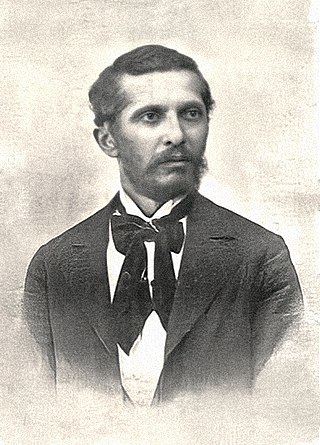
Naim bey Frashëri, more commonly Naim Frashëri, was an Albanian historian, journalist, poet, rilindas and translator who was proclaimed as the national poet of Albania. He is regarded as a pioneer of modern Albanian literature and one of the most influential Albanian cultural icons of the 19th century.
Albanian literature stretches back to the Middle Ages and comprises those literary texts and works written in Albanian. It may also refer to literature written by Albanians in Albania, Kosovo and the Albanian diaspora particularly in Italy. Albanian occupies an independent branch within the Indo-European family and does not have any other closely related language. The origin of Albanian is not entirely known, but it may be a successor of the ancient Illyrian language.

Konitsa is a town of Ioannina in Epirus, Greece. It is located north of the capital Ioannina and near the Albanian border. Konitsa lies northeast of a group of villages known as the Zagorochoria. The town was built amphitheatrically-shaped on a mountain slope of the Pindos mountain range from where it overlooks the valley where the river Aoos meets the river Voidomatis.

Giuseppe Schirò was an Arbëresh neo-classical poet, linguist, publicist and folklorist from Sicily. His literary work marked the transition from the Arbëresh language to modern Albanian literature in Italy. He was a major protagonist of the Rilindja, the Albanian cultural awakening or Albanian Renaissance, in Italy.
Albania is a country on the Balkan Peninsula in south-eastern Europe.
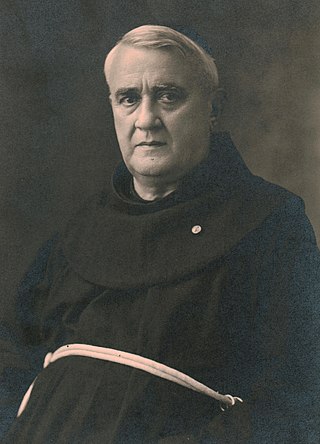
Gjergj Fishta was an Albanian Franciscan friar, poet, educator, politician, rilindas, translator and writer. He is regarded as one of the most influential Albanian writers of the 20th century due to his epic masterpiece Lahuta e Malcís and the editor of two of the most authoritative magazines after Albania's independence, Posta e Shypniës and Hylli i Dritës.
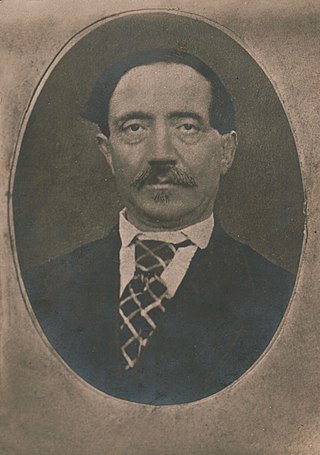
Girolamo de Rada was an Arbëreshë folklorist, journalist, lawyer, playwright, poet, rilindas and writer. He is regarded as one of the most influential Albanian writers of the 19th century who played an essential role in the Albanian Renaissance.
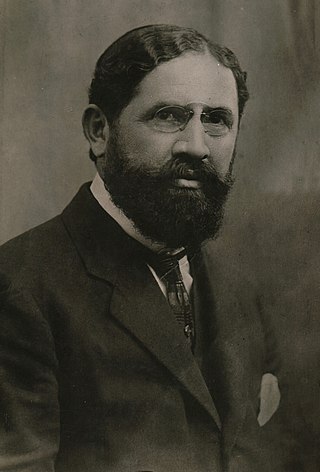
Dervish Hima (1872–1928), born Ibrahim Mehmet Naxhi, was a 19th-century Albanian politician and one of the delegates who participated at the Albanian Declaration of Independence. A publisher, he travelled from country to country, promoting Albania with articles and pamphlets.

Hylli i Dritës is an Albanian periodical first published in 1913 by Gjergj Fishta, one of the most notable writers and poets of Albanian literature. It is regarded as one of the most important Albanian magazines of the early 20th century.

Sotir Kolea (1872-1945) was an Albanian folklorist, diplomat and activist of the Albanian National Awakening. Along with Thoma Kacori he has been labeled as the Last of the Rilindas.
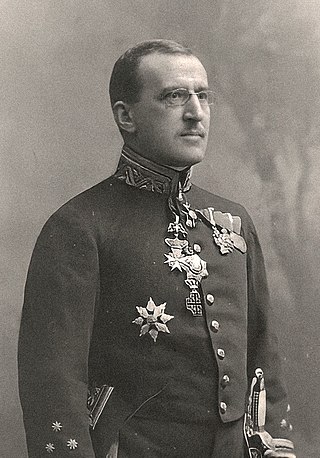
Theodor Anton Max Ippen was an Albanologist and diplomat from Austria-Hungary. Ippen belonged to the group of Albanologists who published their works on Albania through the state-financed institutes of Austria-Hungary in order to create the Albanian national consciousness which he believed would be beneficial for Dual Monarchy. Ippen supported the establishment of an independent nation-state of Albanians. He served as diplomat in Shkoder, Pljevlja, Istanbul, Jerusalem, Athens and London where he advised ambassador of Austria-Hungary during London Conference which ended with signing of the London treaty and a decision to establish the Principality of Albania reached on 29 July 1913. During the period between 1921 and 1927, he was a member of the International Danube Commission.
The literature of Kosovo is composed of literary texts written in Albanian, Serbian, Bosnian, and Turkish, specifically by authors of Kosovo. Kosovo produced several prominent writers in the Ottoman era. However, Ottoman authorities banned the written use of the Albanian language until 1912. This policy continued during Serb rule until the outbreak of World War II.

Ndoc Nikaj was an Albanian priest, writer, and historian. He was the first Albanian novelist to write and publish an original novel in the Albanian language, Shkodra e rrethueme of 1905.
Sulejman Naibi (Ramazani) was an Albanian early period poet of the bejtexhinj era.
Mesihi (Messiah) of Prishtina, known in Ottoman Turkish as Priştinali Mesihi, was one of the best known Ottoman poets of the late 15th and early 16th centuries during the Bayezid II era and is regarded as one of the earliest Albanian poets.

Faik Bey Konica was an important figure in Albanian language and culture in the early decades of the twentieth century. Prewar Albanian minister to Washington, his literary review Albania became the focal publication of Albanian writers living abroad. Faik Konica wrote little in the way of literature, but as a stylist, critic, publicist and political figure he had a tremendous impact on Albanian writing and on Albanian culture at the time.
Stefan Shundi (1906–1947) was an Albanian writer, literary critic, journalist, lawyer, football player, and sports director. During 1933 to 1936 he was president of the KF Tirana football association.

Ilir Ikonomi is an Albanian-American journalist and author who has written several books on the history of Albania. Ikonomi's work, "Pavarësia - Udhëtimi i paharruar i Ismail Qemalit", was included in the year-long celebration of the 100th Anniversary of the Independence of Albania as a literary accomplishment.

The Jesuits in Albania refers to the Jesuits and Jesuit missions in Albania.













